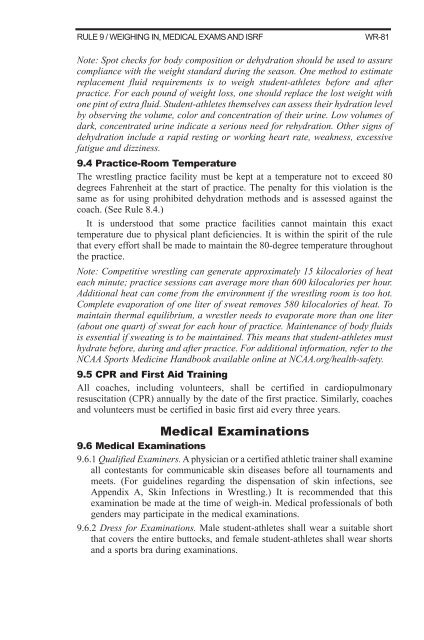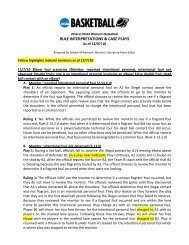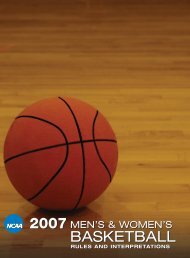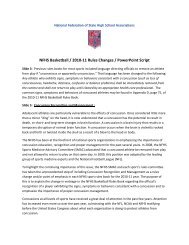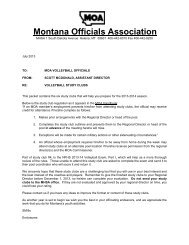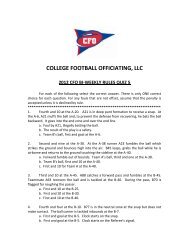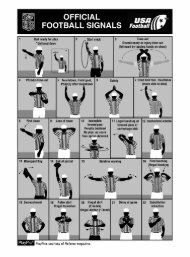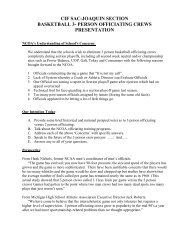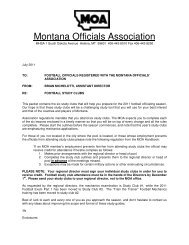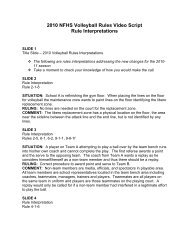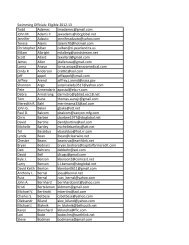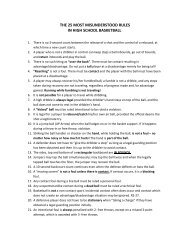(PDF). - NCAA Wrestling Officiating
(PDF). - NCAA Wrestling Officiating
(PDF). - NCAA Wrestling Officiating
You also want an ePaper? Increase the reach of your titles
YUMPU automatically turns print PDFs into web optimized ePapers that Google loves.
RULE 9 / Weighing In, Medical Exams and ISRFWR-81<br />
Note: Spot checks for body composition or dehydration should be used to assure<br />
compliance with the weight standard during the season. One method to estimate<br />
replacement fluid requirements is to weigh student-athletes before and after<br />
practice. For each pound of weight loss, one should replace the lost weight with<br />
one pint of extra fluid. Student-athletes themselves can assess their hydration level<br />
by observing the volume, color and concentration of their urine. Low volumes of<br />
dark, concentrated urine indicate a serious need for rehydration. Other signs of<br />
dehydration include a rapid resting or working heart rate, weakness, excessive<br />
fatigue and dizziness.<br />
9.4 Practice-Room Temperature<br />
The wrestling practice facility must be kept at a temperature not to exceed 80<br />
degrees Fahrenheit at the start of practice. The penalty for this violation is the<br />
same as for using prohibited dehydration methods and is assessed against the<br />
coach. (See Rule 8.4.)<br />
It is understood that some practice facilities cannot maintain this exact<br />
temperature due to physical plant deficiencies. It is within the spirit of the rule<br />
that every effort shall be made to maintain the 80-degree temperature throughout<br />
the practice.<br />
Note: Competitive wrestling can generate approximately 15 kilocalories of heat<br />
each minute; practice sessions can average more than 600 kilocalories per hour.<br />
Additional heat can come from the environment if the wrestling room is too hot.<br />
Complete evaporation of one liter of sweat removes 580 kilocalories of heat. To<br />
maintain thermal equilibrium, a wrestler needs to evaporate more than one liter<br />
(about one quart) of sweat for each hour of practice. Maintenance of body fluids<br />
is essential if sweating is to be maintained. This means that student-athletes must<br />
hydrate before, during and after practice. For additional information, refer to the<br />
<strong>NCAA</strong> Sports Medicine Handbook available online at <strong>NCAA</strong>.org/health-safety.<br />
9.5 CPR and First Aid Training<br />
All coaches, including volunteers, shall be certified in cardiopulmonary<br />
resuscitation (CPR) annually by the date of the first practice. Similarly, coaches<br />
and volunteers must be certified in basic first aid every three years.<br />
Medical Examinations<br />
9.6 Medical Examinations<br />
9.6.1 Qualified Examiners. A physician or a certified athletic trainer shall examine<br />
all contestants for communicable skin diseases before all tournaments and<br />
meets. (For guidelines regarding the dispensation of skin infections, see<br />
Appendix A, Skin Infections in <strong>Wrestling</strong>.) It is recommended that this<br />
examination be made at the time of weigh-in. Medical professionals of both<br />
genders may participate in the medical examinations.<br />
9.6.2 Dress for Examinations. Male student-athletes shall wear a suitable short<br />
that covers the entire buttocks, and female student-athletes shall wear shorts<br />
and a sports bra during examinations.


